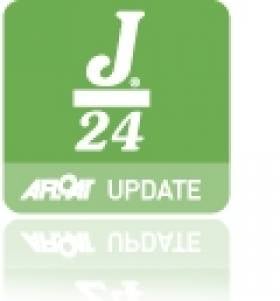Displaying items by tag: Robin Eagleson
Death of J24 Stalwart Robin Eagleson
Lough Erne Yacht Club historian, Michael Clarke reported yesterday via social media the death of Robin Eagleson who passed away on board his motor yacht, October Dream.
It was only a few months ago that he suffered the sad loss of his wife Lorna.
The club is located on the eastern shore of Lower Lough Erne at Goblusk Bay.
Robin's enjoyed cruising and racing; he was an officer in several clubs and was well known in the J24 class. Michael reports that, "significant for LEYC, was the part he played fostering relationships among our Club and others with J/24 fleets, in the J/24 Association of Ireland, of which he was President for a time, and the International J/24 World Council, of which he became Chairman. Robin's meticulous practicality made key contributions throughout to J/24 Sailing, resolving issues, good governance and growth".
 Robin Eagleson at the helm of his J24 Luder Too
Robin Eagleson at the helm of his J24 Luder Too
As J/24 Vice President for international matters, Robin travelled far and wide and such was his standing, that World Council readily agreed that its annual 2006 meeting be in Ireland, at Lough Erne YC. The 20 delegates represented Japan, Australia, Argentina, North America and Europe and after the formal business on Saturday they enjoyed a Sunday in LEYC motor yachts.
Robin took his first J/24, Sheer Jenius from Lough Neagh to LEYC for the club's first J/24 championship in 1986, reported by Winkie Nixon in Afloat. Later Robin bought Luder, a very successful English J/24. Then he bought back Sheer Jenius, combined the best of the pair in one, renamed it Luder Too, and sold the other painted red, as Luder. He raced Luder Too in Lough Neagh in winter and at many J/24 events across Ireland.
On retirement, Robin moved to a fine motor yacht, October Dream, aboard which he sadly died.
Condolences to son Peter, daughter Jayne, Robin's family circle, friends in boating and in J/24 sailing worldwide.
McCaldin Defending Title in Style
His championship defence couldn't have started any better, with three successive bullets. The fourth race was something of a disaster for them finishing 14th but 5th in the final race of the first day sees them two points clear of their major rival for the honours, Flor O'Driscoll (RSt.GYC) on 'Hard on Port' who notched up three third places and a win the final race to stay very much in touch with the defending champion.
Local hopes centre on 'Jibberish' (O'Kelly & Co) and they did not disappoint. Having only taken delivery of the boat two days ago after repairs to serious damage suffered months ago in a T-bone collision, they might be excused for not performing, as they got re-0acquainted with their boat. A results card that included two second places and the most impressive race win of the day – the margin of victory was very impressive – puts the Howth crew in third place overall going into the second day.
Tying on points but ranked as 4th is J/24 Class President Robin Eagleson of Lough Erne YC on 'Luder Too' who also showed great consistency with three second places and might have ended the day even higher up the leader-board if it wasn't for a disastrous last race when the tides played havoc with the distinctively red boat at the windward mark.
Two other northern boats – JP McCaldin's 'Jamais Encore' (Dalgety Bay SC) and 'Sayonara' (D.O'Donovan, LEYC) – fill the next two places overall.
The five windward-leeward races were sailed in varying (although generally fresh) conditions, with headsail changes the order of the day, while the last race threw up gusts of 30 knots plus at the 17-boat fleet. The series concludes on Sunday 12th with three races scheduled by PRO David Lovegrove and his team on 'Free Enterprise'.
J/24 National Championship – overall places after 5 races:
Mickey McCaldin – LEYC – 8 points
Flor O'Driscoll – RStGYC – 10 points
Fergus O'Kelly & Co. – HYC – 14 points
Robin Eagleson – LEYC – 14 points
J.P. McCaldin (DBSC) – 20 points
D.O'Donovan – LEYC – 20 points
Photo Gallery by Gareth Craig HERE
























































